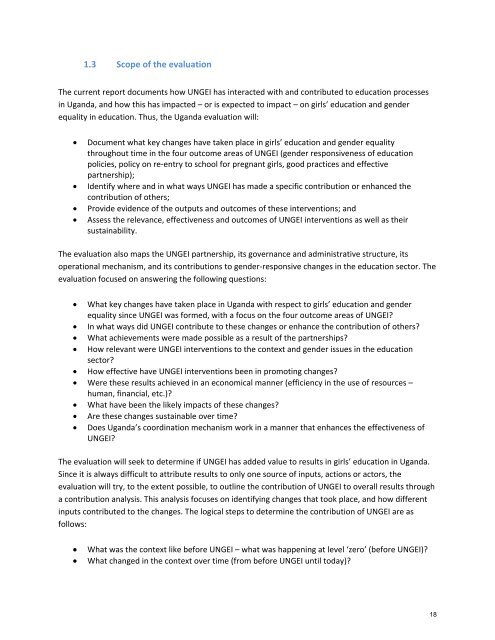Uganda Evaluation - United Nations Girls' Education Initiative
Uganda Evaluation - United Nations Girls' Education Initiative
Uganda Evaluation - United Nations Girls' Education Initiative
Create successful ePaper yourself
Turn your PDF publications into a flip-book with our unique Google optimized e-Paper software.
1.3 Scope of the evaluation<br />
The current report documents how UNGEI has interacted with and contributed to education processes<br />
in <strong>Uganda</strong>, and how this has impacted – or is expected to impact – on girls’ education and gender<br />
equality in education. Thus, the <strong>Uganda</strong> evaluation will:<br />
<br />
<br />
<br />
<br />
Document what key changes have taken place in girls’ education and gender equality<br />
throughout time in the four outcome areas of UNGEI (gender responsiveness of education<br />
policies, policy on re‐entry to school for pregnant girls, good practices and effective<br />
partnership);<br />
Identify where and in what ways UNGEI has made a specific contribution or enhanced the<br />
contribution of others;<br />
Provide evidence of the outputs and outcomes of these interventions; and<br />
Assess the relevance, effectiveness and outcomes of UNGEI interventions as well as their<br />
sustainability.<br />
The evaluation also maps the UNGEI partnership, its governance and administrative structure, its<br />
operational mechanism, and its contributions to gender‐responsive changes in the education sector. The<br />
evaluation focused on answering the following questions:<br />
What key changes have taken place in <strong>Uganda</strong> with respect to girls’ education and gender<br />
equality since UNGEI was formed, with a focus on the four outcome areas of UNGEI?<br />
In what ways did UNGEI contribute to these changes or enhance the contribution of others?<br />
What achievements were made possible as a result of the partnerships?<br />
How relevant were UNGEI interventions to the context and gender issues in the education<br />
sector?<br />
How effective have UNGEI interventions been in promoting changes?<br />
Were these results achieved in an economical manner (efficiency in the use of resources –<br />
human, financial, etc.)?<br />
What have been the likely impacts of these changes?<br />
Are these changes sustainable over time?<br />
Does <strong>Uganda</strong>’s coordination mechanism work in a manner that enhances the effectiveness of<br />
UNGEI?<br />
The evaluation will seek to determine if UNGEI has added value to results in girls’ education in <strong>Uganda</strong>.<br />
Since it is always difficult to attribute results to only one source of inputs, actions or actors, the<br />
evaluation will try, to the extent possible, to outline the contribution of UNGEI to overall results through<br />
a contribution analysis. This analysis focuses on identifying changes that took place, and how different<br />
inputs contributed to the changes. The logical steps to determine the contribution of UNGEI are as<br />
follows:<br />
<br />
<br />
What was the context like before UNGEI – what was happening at level ‘zero’ (before UNGEI)?<br />
What changed in the context over time (from before UNGEI until today)?<br />
18
















